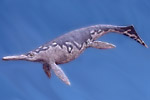Paleontology and geologyThe Precambrian: Few Early Precambrian rocks are preserved in Nevada. Fossils of blue-green bacteria in some Late Precambrian rocks in the southern and eastern part of the state indicate that shallow seas began to flood the edge of a quiet continental margin.
The Paleozoic: In contrast, Paleozoic rocks are well represented in Nevada. Warm shallow seas gradually flooded the state during the early part of this time interval and continued to cover the southern and eastern part of the state through the Devonian, but the water deepened into an ocean basin to the northwest. Reef communities flourished in the shallower parts of the sea, while fossils of graptolites and other floating organisms are preserved in some of the deep-water deposits. An episode of mountain building (the Antler Orogeny) occurred toward the end of the Devonian and continued into the early part of the Carboniferous. By the Permian, sea level had dropped and parts of Nevada were dry land. Plant fossils can be found in rocks formed in shallow lagoons and beaches in the eastern part of the state, while scattered reefs still existed in the north and northeast. Deep oceans persisted in the northwest, and the chert and shale from this time are rich in the fossils of plankton.
The Mesozoic: The Mesozoic was a time of changing sea level and intense tectonic activity. In the Triassic, the ocean continued to recede; however, deeper water persisted in the central and western parts of the state, and fossils of ichthyosaurs and ammonites are abundant. Rocks from the Jurassic indicate a deep-water environment limited to the northwest, a shallow marine environment in the central area, and non-marine environments to the south and east. Cretaceous rocks are rare in Nevada, but they indicate that a volcanic island arc formed along the western edge of the state. Scattered twigs believed to be from Sequoia trees are reported from Eureka County are the only known Cretaceous fossils from the state.
The Cenozoic: During the Early Cenozoic (Tertiary), tectonic activity was intense and blocks of crust rose to form mountains, while others dropped to form basins, initiating the Basin and Range Province we see today. Mammoths, rhinos, and horses roamed through woodlands populated with oak, redwood, and willow. Volcanic eruptions were frequent. During the Late Cenozoic (Quaternary), the Sierra Nevada Mountains were uplifted, and glaciers sculpted the highest peaks. Mammoths, horses, camels, and giant ground sloths roamed freely. Volcanic eruptions continued throughout the state, depositing ash flows and lava. |

